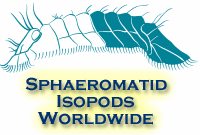| Abstract |
1. The blind isopod Caecidotea tridentata is the dominant invertebrate in a simple community of subterranean organisms inhabiting the local, shallow aquifer under Konza Prairie, Kansas, U.S.A. 2. The ecology of this karst aquifer was explored by sieving water from a spring, collecting water samples for analysis, and manipulating sediments and invertebrates in the laboratory. The size frequency distribution was stable and gravid females were present throughout the year, suggesting continuous reproduction. 3. The number of isopods collected per litre was negatively correlated with discharge and the abundance of bacteria, but positively related to the numbers of an amphipod (Bactrurus hubrichti). This may be explained if both the isopods and the amphipods track the saturated zone below the top of the water table; at lower discharge, the top of the water table is closer to the spring outlet. The suspended bacteria wash out in greater numbers with high discharge. 4. When isopods and carbon were added in a pairwise experimental design to sediments collected from the aquifer, the isopods significantly stimulated numbers and activity of planktonic and sedimentary bacteria, while carbon had no effect. This suggests that invertebrates can affect the microbes locally in an aquifer. |

















